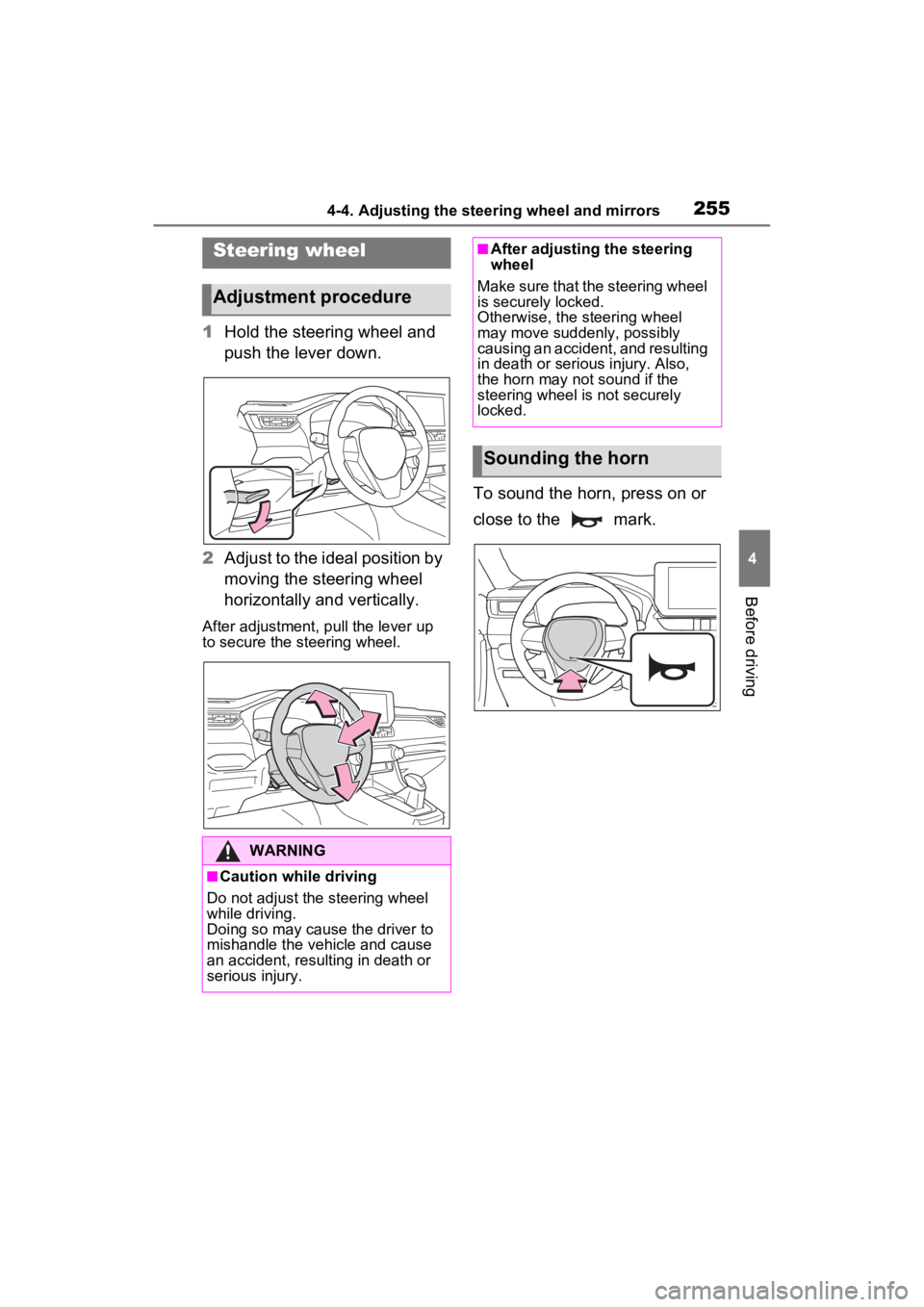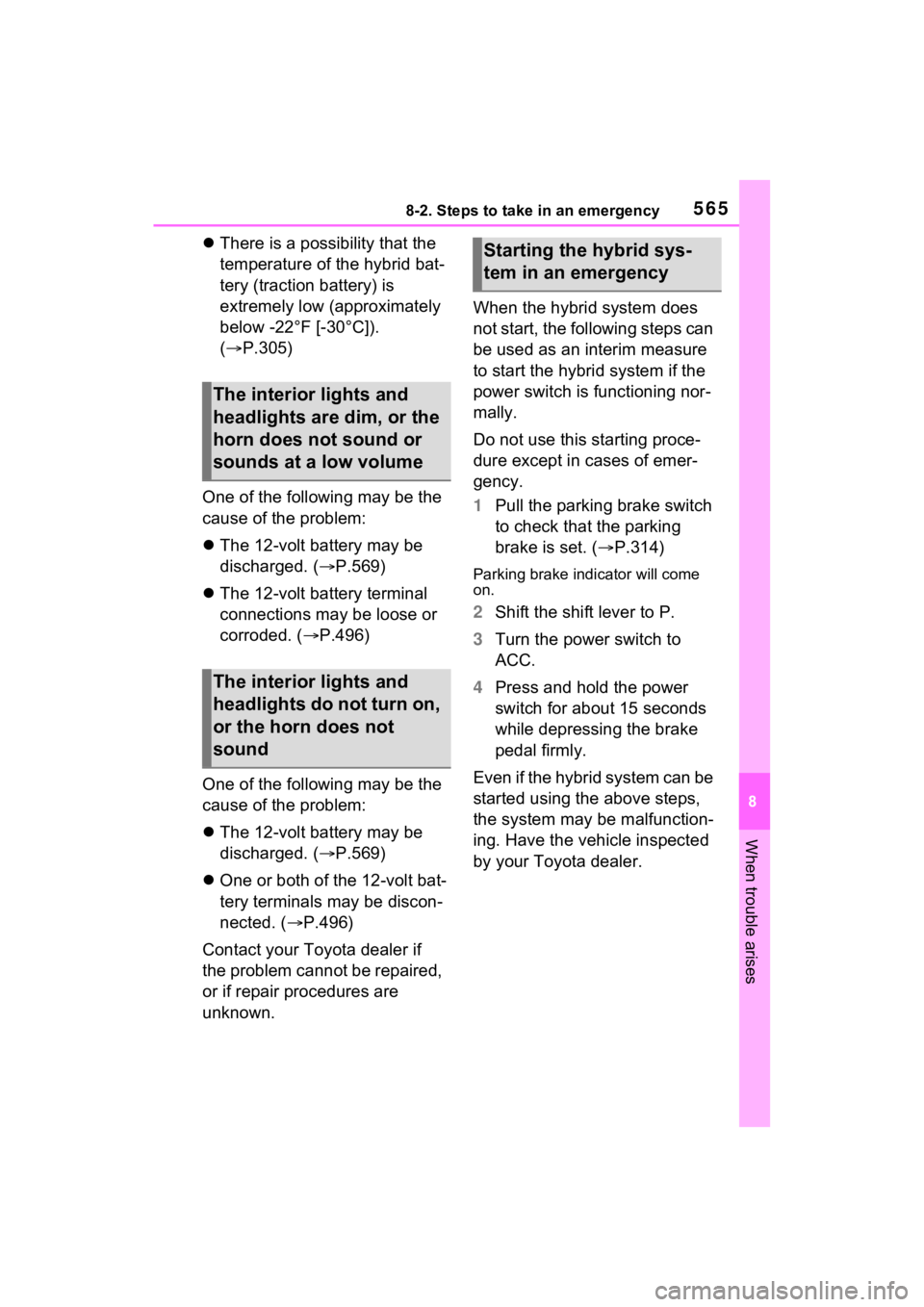2023 TOYOTA RAV4 PRIME horn
[x] Cancel search: hornPage 255 of 662

2554-4. Adjusting the steering wheel and mirrors
4
Before driving
4-4.Adjusting the steering wheel and mirrors
1Hold the steering wheel and
push the lever down.
2 Adjust to the ideal position by
moving the steering wheel
horizontally and vertically.
After adjustment, pull the lever up
to secure the steering wheel.
To sound the horn, press on or
close to the mark.
Steering wheel
Adjustment procedure
WARNING
■Caution while driving
Do not adjust the steering wheel
while driving.
Doing so may cause the driver to
mishandle the vehicle and cause
an accident, resul ting in death or
serious injury.
■After adjusting the steering
wheel
Make sure that the steering wheel
is securely locked.
Otherwise, the steering wheel
may move suddenly, possibly
causing an accident, and resulting
in death or serious injury. Also,
the horn may not sound if the
steering wheel is not securely
locked.
Sounding the horn
Page 389 of 662

3915-5. Using the driving support systems
5
Driving
■Situations in which the system
may not operate properly
Certain vehicle conditions and the
surrounding environment may affect
the ability of a sensor to correctly
detect objects. Particular instances
where this may occur are listed
below.
●There is dirt, snow or ice on a sen-
sor. (Cleaning the sensors will
resolve this problem.)
●A sensor is frozen. (Thawing the
area will resolve this problem.)
In especially cold weather, if a
sensor is frozen the sensor dis-
play may be displayed abnor-
mally, or objects, such as a wall,
may not be detected.
●When a sensor or the area around
a sensor is extremely hot or cold.
●On an extremely bumpy road, on
an incline, on gravel, or on grass.
●When vehicle horns, vehicle
detectors, motorcycle engines, air
brakes of large vehicles, the clear-
ance sonar of other vehicles or
other devices which produce ultra-
sonic waves are near the vehicle.
●A sensor is coated with a sheet of
spray or heavy rain.
●If objects draw too close to the
sensor.
●When a pedestrian is wearing
clothing that does not reflect ultra-
sonic waves (ex. skirts with gath-
ers or frills).
●When objects that are not perpen-
dicular to the gr ound, not perpen-
dicular to the v ehicle traveling
direction, uneven, or waving are in
the detection range.
●Strong wind is blowing.
●When driving in inclement weather
such as fog, snow or a sandstorm.
●When an object that cannot be
detected is between the vehicle
and a detected object.
●If an object such as a vehicle,
motorcycle, bicycle or pedestrian
cuts in front of the vehicle or runs
out from the side of the vehicle.
●If the orientation of a sensor has
been changed due to a collision or
other impact.
●When equipment that may
obstruct a sensor is installed, such
as a towing eyelet, bumper pro-
tector (an additional trim strip,
etc.), bicycle c arrier, or snow
plow.
●If the front of the v ehicle is raised
or lowered due to the carried load.
●If the vehicle cannot be driven in a
stable manner, such as when the
vehicle has been in an accident or
is malfunctioning.
●When tire chains, a compact
spare tire or an emergency tire
puncture repai r kit are used.
■Situations in which the system
may operate even if there is no
possibility of a collision
In some situations, such as the fol-
lowing, the system may operate
even though there is no possibility of
a collision.
●When driving on a narrow road.
●When driving towa rd a banner,
flag, low-hanging branch or boom
barrier (such as those used at rail-
road crossings, toll gates and
Page 390 of 662

3925-5. Using the driving support systems
parking lots).
●When there is a rut or hole in the
surface of the road.
●When driving on a metal cover
(grating), such as those used for
drainage ditches.
●When driving up or down a steep
slope.
●If a sensor is hit by a large amount
of water, such as when driving on
a flooded road.
●There is dirt, snow, water drops or
ice on a sensor. (Cleaning the
sensors will resolve this problem.)
●A sensor is coated with a sheet of
spray or heavy rain.
●When driving in inclement weather
such as fog, snow or a sandstorm.
●When strong winds are blowing.
●When vehicle horns, vehicle
detectors, motorcycle engines, air
brakes of large vehicles, the clear-
ance sonar of other vehicles or
other devices which produce ultra-
sonic waves are near the vehicle.
●If the front of the vehicle is raised
or lowered due to the carried load.
●If the orientation of a sensor has
been changed due t o a collision or
other impact.
●The vehicle is approaching a tall
or curved curb.
●Driving close to columns (H-
shaped steel beams, etc.) in multi-
story parking garages, construc-
tion sites, etc.
●If the vehicle cannot be driven in a
stable manner, such as when the
vehicle has been in an accident or is malfunctioning.
●On an extremely bumpy road, on
an incline, on gravel, or on grass.
●When tire chains, a compact
spare tire or an emergency tire
puncture repai
r kit are used.
■Detection range of the sen-
sors
Approximately 3.3 ft. (100
cm)
Approximately 4.9 ft. (150
cm)
Approximately 2.0 ft. (60 cm)
The diagram shows the detection
range of the sensors. Note that the
sensors cannot detect objects that
Sensor detection display,
object distance
A
B
C
Page 563 of 662

5658-2. Steps to take in an emergency
8
When trouble arises
There is a possibility that the
temperature of the hybrid bat-
tery (traction battery) is
extremely low (approximately
below -22°F [-30°C]).
( P.305)
One of the following may be the
cause of the problem:
The 12-volt battery may be
discharged. ( P.569)
The 12-volt battery terminal
connections may be loose or
corroded. ( P.496)
One of the following may be the
cause of the problem:
The 12-volt battery may be
discharged. ( P.569)
One or both of the 12-volt bat-
tery terminals may be discon-
nected. ( P.496)
Contact your Toyota dealer if
the problem cannot be repaired,
or if repair procedures are
unknown. When the hybrid system does
not start, the following steps can
be used as an interim measure
to start the hybrid system if the
power switch is functioning nor-
mally.
Do not use this starting proce-
dure except in cases of emer-
gency.
1
Pull the parking brake switch
to check that the parking
brake is set. ( P.314)
Parking brake indicator will come
on.
2 Shift the shift lever to P.
3 Turn the power switch to
ACC.
4 Press and hold the power
switch for about 15 seconds
while depressing the brake
pedal firmly.
Even if the hybrid system can be
started using the above steps,
the system may be malfunction-
ing. Have the vehicle inspected
by your Toyota dealer.
The interior lights and
headlights are dim, or the
horn does not sound or
sounds at a low volume
The interior lights and
headlights do not turn on,
or the horn does not
sound
Starting the hybrid sys-
tem in an emergency
Page 631 of 662

633What to do if... (Troubleshooting)
Is the 12-volt battery dis-
charged? ( P.569)
Is the power switch in ON?
If you cannot release the shift
lever by depressing the brake
pedal with the power switch in
ON ( P.311)
Is the window lock switch
pressed?
The power window except for
the one at the driver’s seat
cannot be operated if the win-
dow lock switch is pressed.
( P.272)
The auto power off function
will be operated if the vehicle
is left in ACC or ON (the
hybrid system is not operat-
ing) for a period of time.
( P.308)
The seat belt reminder light is
flashing
Are the driver and the passengers wearing the seat belts? (
P.548)
The parking brake indicator is
on
Is the parking br ake released?
(
P.314)
Depending on the situation,
other types of warning buzzer
may also sound. ( P.541, 552)
Did anyone inside the vehicle
open a door during setting the
alarm?
The sensor detects it and the
alarm sounds. ( P.71)
To stop the alarm, turn the power
switch to ON or start the hybrid sys-
tem.
Is the message displayed on
the multi-information display?
Check the message on the
multi-information display.
( P.552)
When a warning light turns on
or a warning message is dis-
played, refer to P.541, 552.
The shift lever cannot be
shifted from P even if you
depress the brake pedal
The windows do not open
or close by operating the
power window switches
The power switch is
turned off automatically
A warning buzzer sounds
during driving
An alarm is activated and
the horn sounds (if
equipped)
A warning buzzer sounds
when leaving the vehicle
A warning light turns on
or a warning message is
displayed
Page 639 of 662

Alphabetical Index641
ing light ................................. 542
High mounted stoplight Replacing light bulbs ............ 528
High voltage components ....... 85
Hill-start assist control .......... 407
Hood ........................................ 486 Warning message ................ 552
Hooks Cargo hooks ......................... 442
Coat hooks ........................... 455
Retaining hooks (floor mat) .... 26
Horn ......................................... 256
HV mode .................................... 75
Hybrid battery (tr action battery)
Charging....................... 113, 121
Location.................................. 85
Specification ......................... 582
Hybrid battery (traction battery) charge mode ........................... 77
Hybrid system Acoustic Vehicle Alerting System............................................. 83
Brake Override System ........ 283
Emergency shut off system .... 89
Energy monitor/consumption screen ................................ 212
High voltage components....... 85
How to start the hybrid system ........................................... 304
Hybrid System Indicator ....... 173
If the hybrid sy stem will not start
........................................... 564
If your vehicle has to be stopped in an emergency................. 535
Ignition switch (power switch) ........................................... 304
Overheating.......................... 574
Plug-in Hybrid Electric Vehicle driving tips ............................ 90
Plug-in hybrid system precau- tions...................................... 85
Power (ignition) switch ......... 304 Regenerative braking .............80
Starting the hybrid system ....304
Hybrid System Indicator 173, 181
Hybrid transmissio n ...............309
S mode .................................312
I
I/M test .....................................482
Identification number Engine ..................................581
Vehicle..................................580
Ignition switch (power switch) ...............................................304Auto power off fun ction.........308
Changing the power switch modes.................................307
If your vehicle has to be stopped in an emergency .................535
Starting the hybrid system ....304
Immobilizer system ..................70
Indicators ................................166
Initialization Items to initialize ...................615
Maintenance .........................479
Moon roof .............................274
Panoramic moon r oof ...........277
Power back door ..................236
Power windows ....................270
Tire pressure warning system ...................................503, 504
Inside rear view m irror ...257, 258
Instrument panel light control ...............................................177
Interior lights...........................436 Switch ...................................437
Intuitive parking assist Function................................387
Warning message . ...............390
J
Jack